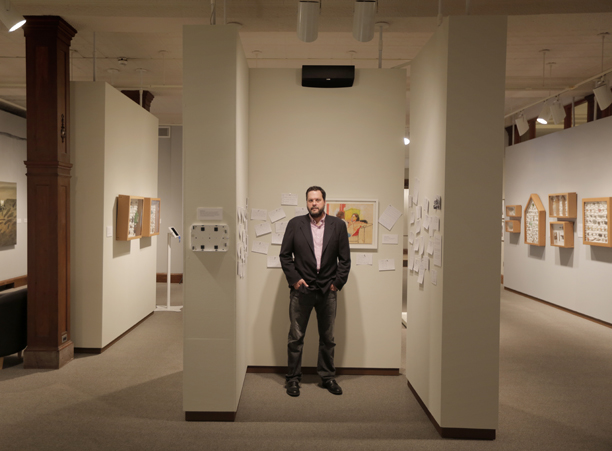
This semester, 12 Holy Cross students are learning about disaster — how we visualize, discuss, digest, and commemorate it — from a sociological perspective, with an art twist.
Daina Cheyenne Harvey, assistant professor of sociology at the College, has developed a course, “Disaster, Media, and Culture,” in tandem with curating the current Cantor Art Gallery exhibition, “Katrina Then and Now: Artists as Witness,” that focuses on how art and culture have been used to document, explain, and deal with the aftermath of Hurricane Katrina. This particular lens offers unique insight into the immediate and long-term appropriation of what is considered one of the worst disasters in American history.
“Increasingly, I’ve become interested in the cultural aspect of disasters, which is very understudied within sociology,” says Harvey, who had received repeated requests from students to offer a course solely on Hurricane Katrina. “In a way this course was a motivator and a way to start looking at culture and disaster as a topic of research, or culture as a way to study disaster.”
In the small group seminar, students are engaging with text, music, films, newspapers, paintings, plays and photography, as a means of studying disasters such as Sept. 11, the 1923 earthquake in Tokyo, and the Holocaust. Outside of the classroom, coursework is augmented by lectures from prominent figures in the art world and various academic fields, as well trips to exhibitions depicting and commemorating disaster, including the 9/11 Memorial Museum in New York.
“What I’ve learned from this course so far is that art plays a key role in the sensemaking process in the wake of a disaster,” says Danielle Tierney ‘16, a sociology major whose interest in the topic of disaster drew her to enroll in the course. “It is through art that we can begin to better understand the rich personal narratives and the complex picture they might provide about a specific disaster.”
On-Campus Exhibit Informs Studies
The gallery exhibition, which is just a short walk from the students’ classroom, has added an additional dimension to an already multifaceted course.
“We are constantly referring back to it,” explains Harvey. “Going back every now and then and relooking at things after the students have begun studying the topic gives them more of an idea about the art, a different way to appreciate it or critique it or to make sense of what their seeing.”
The students’ growing understanding of the seminar topic has been seen through their evolving relationship with the exhibition itself. “The first time we went over, they saw the exhibition as being like any other gallery or museum,” says Harvey. “But now that they’ve read about disaster, art, and culture, they say, ‘I can see why they would use these images, or I can see why this is powerful, or the similarities and the contrasts between other disasters we’ve studied and what these artists have done.’”
Tierney says the exhibition has added valuable context to the seminar. “Having the exhibition as a part of our class has made the mission of the course come alive,” she says. “Many of us in the class are unfamiliar with the rich culture in New Orleans. Visiting the gallery and viewing first-hand ways in which New Orleans natives have visualized Hurricane Katrina offers us unique insight and perspective into its culture.”
A sociology seminar and an art gallery exhibition may seem like an unorthodox pairing, but Harvey has managed to show that the more unassuming the combination, the more interesting the results.
“The gallery show adds a complete new dimension to the topic, allowing the students, and those visiting the exhibition, to understand disaster in a much deeper way,” he explains. “I thought this would be a new and more interesting way to tell the story.”
Connection to New Orleans
Harvey’s connection to New Orleans extends beyond his academic interests, having grown up in and around the city until the age of 14. He moved back to the still-devastated city in 2010 to help rebuild homes and work on community projects in the Lower Ninth Ward, while simultaneously writing his dissertation on the rebuilding efforts for Rutgers University. During this period, his interest only grew.
“One of the things that interested me while I was in New Orleans was how much new art and new artists I kept running into,” says Harvey. “When I arrived at Holy Cross to teach in 2012, I was inspired by a colleague to curate an exhibition as a way of exploring how artists responded to Katrina.”
The College has supported the interdisciplinary project from the start, Harvey says. “To me, that is really unique and I think says a lot about Holy Cross. I can be more creative here than I probably could at other places.”
The second half of the semester has seen the transition of the two-part exhibition, which aims to reflect two distinct periods and purposes in and for which the art was created, he explains.
“As we now turn to the second part of the exhibition, we go beyond documenting and describing to focus on the various social and political stories artists were telling in the long-term aftermath of Hurricane Katrina.”
“Part II: The Rebirth of the Artist“ runs through Dec. 18 and features work by Dawn DeDeaux, a fixture in the New Orleans art world for the last five decades and considered one of America’s pioneering artists in new media. Other prominent artists include Tameka Norris, Rontherin Ratliff, and Dan Tague; and Matt Vis and Tony Campbell of Generic Art Solutions. A series of artists’ talks, films and special events will continue through the end of the semester. More information on the exhibition can be found on the Cantor Art Gallery website.
Related Information
- Cantor Art Gallery’s Exhibit on Hurricane Katrina Featured in Worcester Living Magazine
- Hurricane Katrina Exhibit at Holy Cross Featured on National Radio

